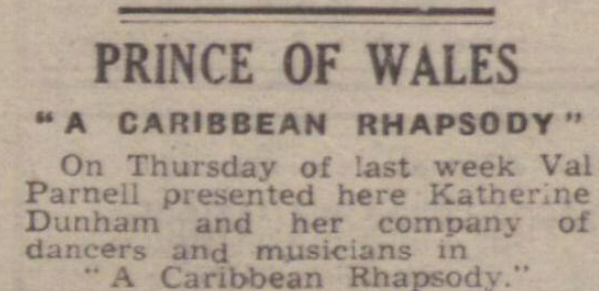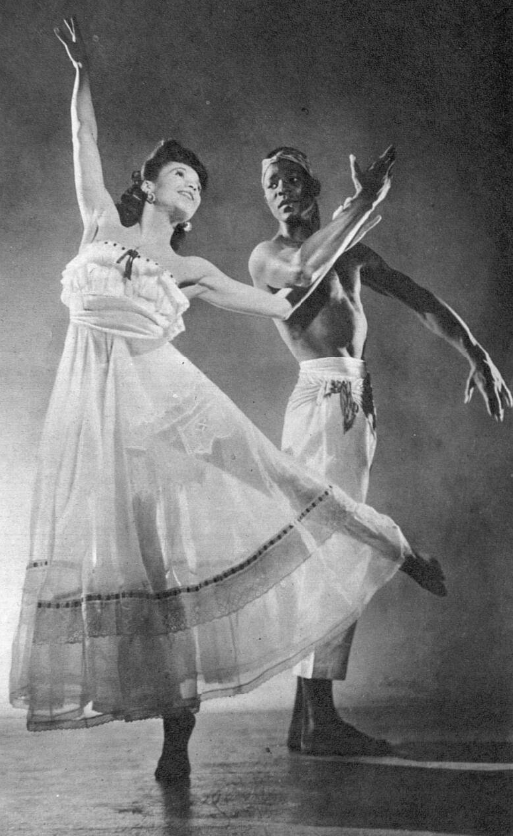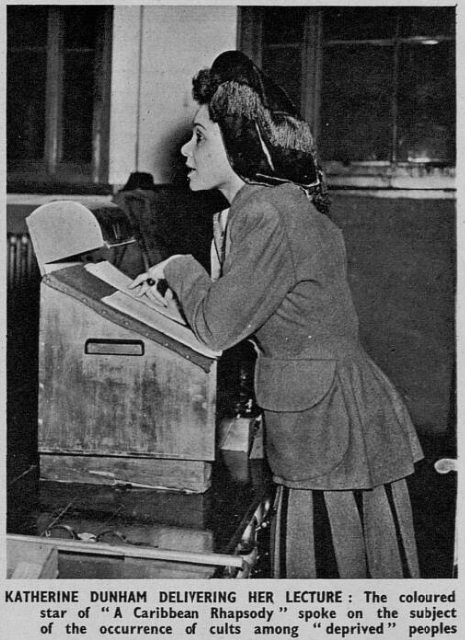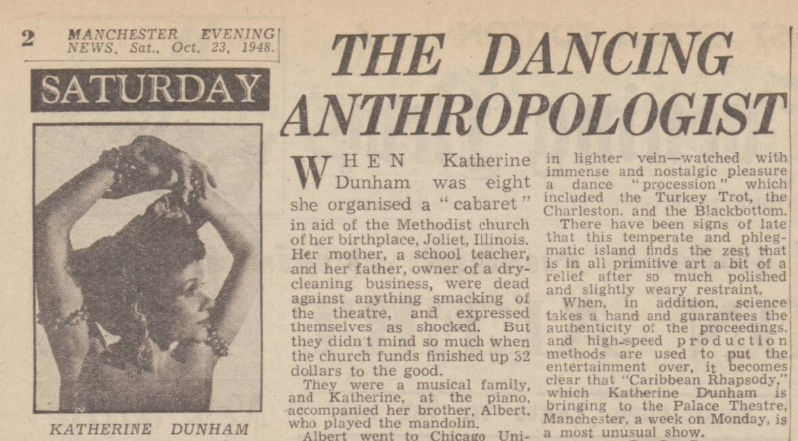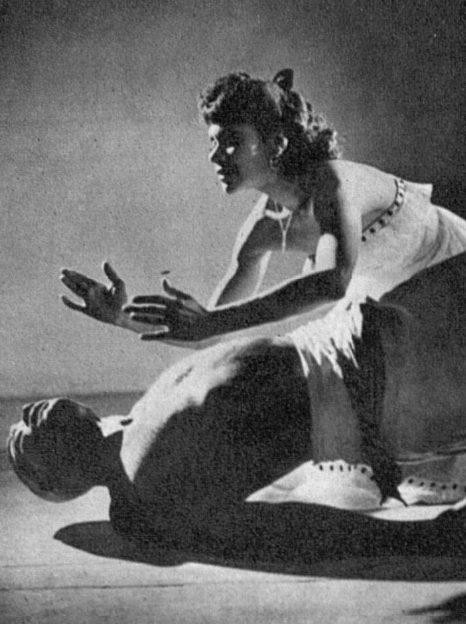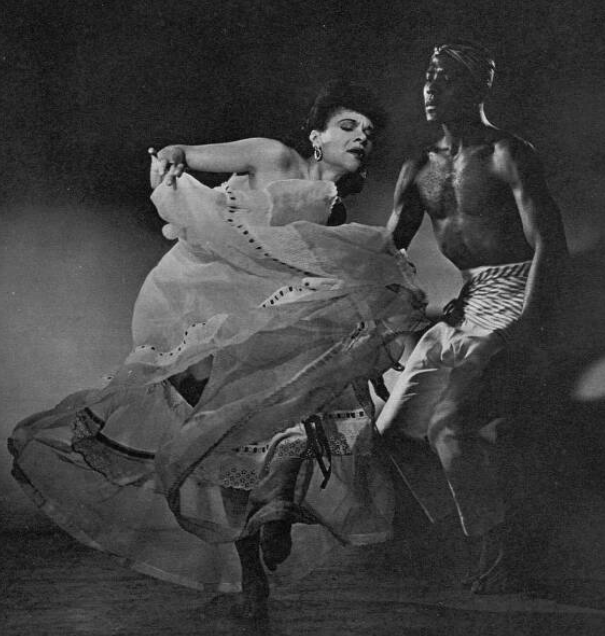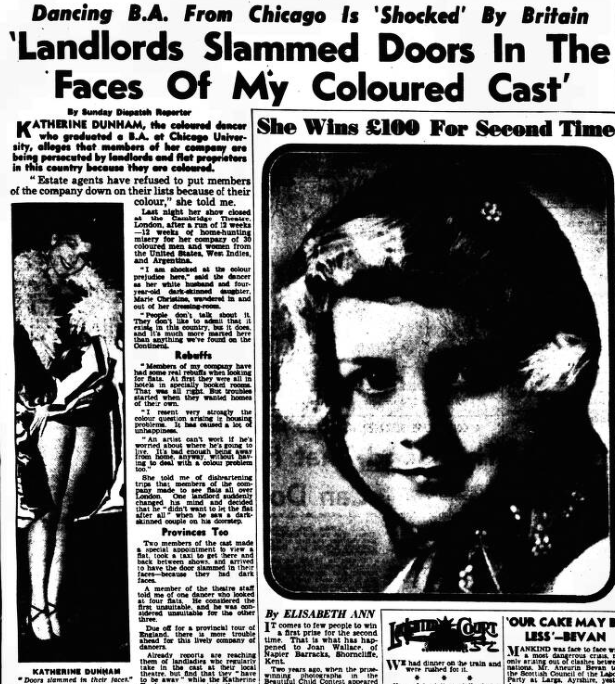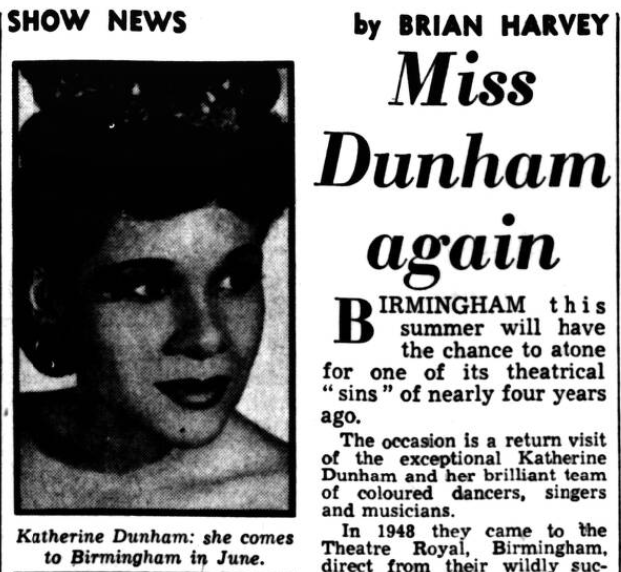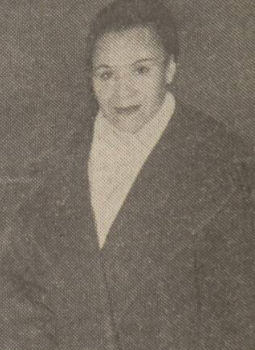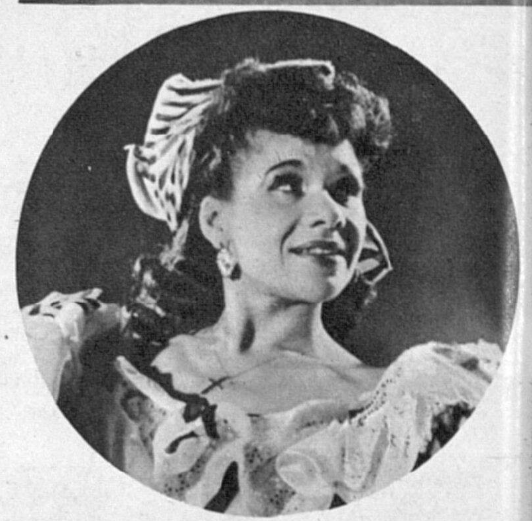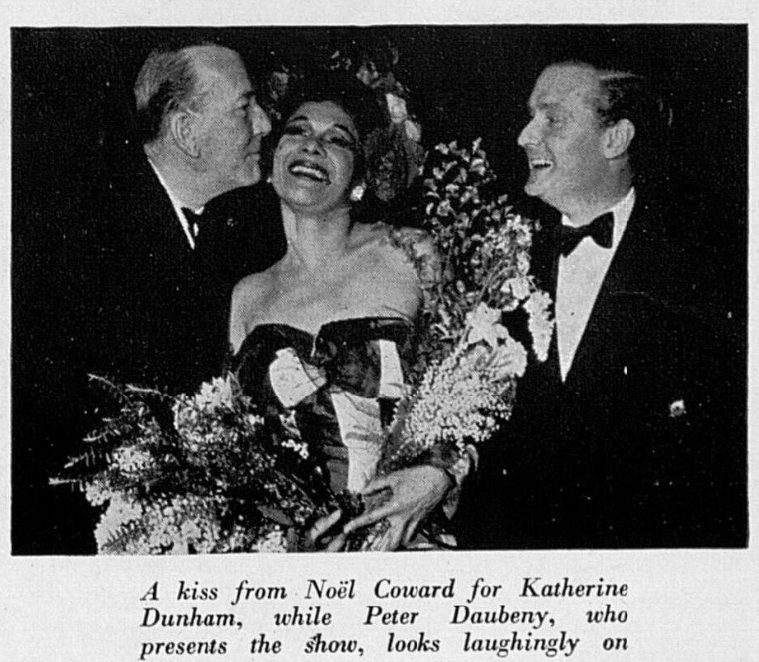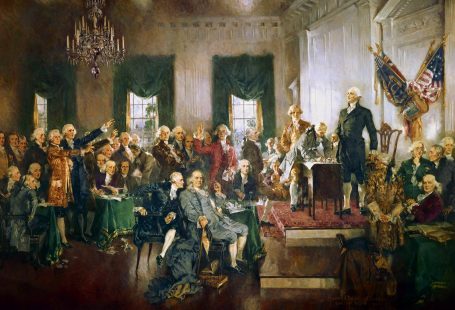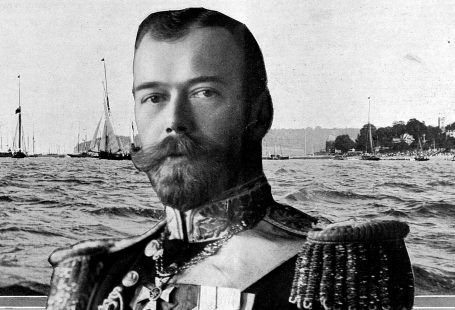Born in 1909 in Chicago, ‘dancing anthropologist’ Katherine Dunham was known as the ‘matriarch and queen mother of Black dance.’ Her father was a descendant of enslaved West Africans and Madagascans, whilst her mother hailed from Canada.
A multitalented artist, academic and activist, for many years Katherine Dunham ran the Katherine Dunham Dance Company, the only self-supporting African-American dance troupe in the mid-twentieth century. It was during this time that Dunham toured the United Kingdom, and in this special blog, we learn more about her visits to Great Britain and Ireland, and how she and her dance company was received by the press of the day.
Please do be aware that some historical newspapers use outmoded language to describe race, such as is considered offensive today.
‘A Caribbean Rhapsody’
Katherine Dunham appears in our Archive with bang in 1948, as a review of her show ‘A Caribbean Rhapsody‘ appeared in special theatre and entertainment publication The Stage. The piece describes how:
On Thursday last week Val Parnell presented here Katherine Dunham and her company of dancers and musicians in ‘A Caribbean Rhapsody.’ An unusual show this, but an attractive one, for Katherine Dunham and her company are vital and vivacious in their artistic work.
The Stage describes how the show was ‘divided into three parts.’ The first section included a selection of ‘old-time dances,’ whilst the second featured a performance of a story, penned by Katherine Dunham, called ‘L’Ag’ya.’ The show was rounded off with a presentation of ‘modern songs and dances.’
The review was most impressed, however, by the performance of Katherine Dunham herself, relating how:
Katherine Dunham makes her first appearance quite early in the show. She is a capable artist and her dancing, miming, and singing are excellent. She plays many parts, and brings to them all a delightful sense of humour and joie de vivre. In the second act, particularly, she displays histrionic ability, and in the ‘Blues’ scena in the final part of the programme is at her best, with delicious burlesque added to her beautiful dancing.
Such was the success of ‘A Caribbean Rhapsody’ that The Stage tells us how ‘Miss Dunham had six curtain calls on the first night, and changed her dress for each of them!’
‘A Theatrical Star at University College’
Katherine Dunham was to take on a completely different role, however, a few months later when she spoke to members of the Royal Anthropological Institute at University College. Not only was Dunham a talented dancer and choreographer, she had also studied anthropology extensively, receiving a degree from Chicago University .
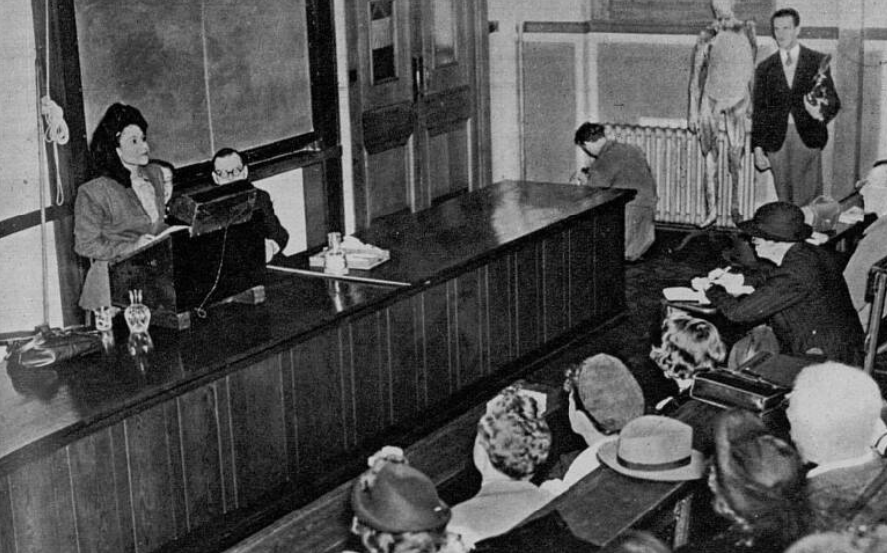
The Sphere on 16 October 1948 described how Katherine Dunham had given a lecture to the Royal Anthropological Institute, taking ‘as her subject the occurrence of cults among peoples whose connection with their traditional culture has been lost.’ She spoke about such sects as the Abyssinians, the Temple of Israel and Father Divine as ‘examples of compensation for the oppression’ of the Black population in the United States.
After the lecture, The Sphere relates how Dunham ‘conducted a discussion of the subject with considerable skill.’
‘The Dancing Anthropologist’
In the same month, October 1948, the Manchester Evening News took a closer look at the life and work of ‘the dancing anthropologist‘ Katherine Dunham. The newspaper described this incident from earlier in her life:
When Katherine Dunham was eight she organised a ‘cabaret’ in aid of the Methodist church of her birthplace, Joliet, Illinois. Her mother, a school teacher, and her father, owner of a dry-cleaning business, were dead against anything smacking of the theatre, and expressed themselves as shocked. But they didn’t mind so much when the church funds finished up 32 dollars to the good.
A flair for music was evident in her family, her brother Albert played the mandolin, and Katherine followed in his footsteps by studying at Chicago University. She developed an interest in anthropology, and particularly in the dances of different populations. Then, a meeting with philanthropist Edith Rosenwald Stern would change the course of her life. After the philanthropist came across one of Katherine’s performances in ‘an abandoned loft,’ the pair encountered each other again at the Rosenwald Foundation. Katherine Dunham was asked for what she would like funding, and the Manchester Evening News described what happened next:
‘Well,’ she said, ‘I’ll show you.’ Whereupon, no doubt to the bewilderment of the committee, she broke into an African war-dance, pausing to say: ‘I want to go where they dance like that. I want to learn how to teach people about the negro.’ Miss Dunham spent the next 18 months (and two fellowships) investigating the Caribbean islands, to which the dance lore came with the slaves from Africa.
After returning from her studies, she lectured at the Yale University Anthropological Club, contributed to different scientific journals, and of course, founded her dance company. Her choreography was fused with her learnings, taking its cues from African, Caribbean, and South American dance traditions, and these were the dances she brought to the United Kingdom.
Katherine Dunham is ‘Back in Town’
A few years later on 10 January 1952 The Scotsman reported how ‘Katherine Dunham is back in town with her troupe.’ The company were starting a new season with a new ballet, which ‘began in Brazil and moves up to the United States by way of the company’s own West Indies.’ The Scotsman hailed the show’s ‘remarkable fusion of scholarship and entertainment,’ whilst lauding Katherine Dunham’s ‘great charm and style.’ All in all, the reviewer was left with an impression of ‘elegant exuberance.’
Meanwhile, picture-rich publication The Sketch described how the new show combined ‘a primitive violence of sight, sound and movement with the style and polish of considerable art.’ The review explained how Katherine Dunham and her ‘company are proposing to remain here for a season of four months.’
Slammed Doors
But it was not an entirely happy trip to the United Kingdom, as the Weekly Dispatch (London) reported a few months later on 30 March 1952, as the country’s racial intolerance came to the fore. Under the impactful headline ‘Dancing B.A. From Chicago is ‘Shocked’ by Britain – ‘Landlords Slammed Doors In The Faces of My Coloured Cast.” it was reported how Katherine Dunham and her company faced racism when they tried to look for lodgings.
A reporter for the Weekly Dispatch was told by Dunham herself how ‘estate agents have refused to put members of the company down on their lists because of their colour,’ in spite of the company putting on a successful twelve week run in London.
Katherine Dunham was quoted by the Weekly Dispatch as saying:
I am shocked at the colour prejudice here…People don’t talk about it. They don’t like to admit that it exists in this country, but it does, and it’s much more marked here than anything we’ve found on the Continent. Members of my company have had some real rebuffs when looking for flats. At first they were all in specially booked rooms. That was all right. But troubles started when they wanted homes of their own. I resent very strongly the colour question arising in housing problems. It has caused a lot of unhappiness. An artist can’t work if he’s worried about where he’s going to live. It’s bad enough being away from home, anyway, without having to deal with the colour problem.
She gave examples of shocking racism, from one landlord deciding he ‘didn’t want to let the flat after all’ when a Black couple came for a viewing, with another two cast members having the door slammed in their faces after they had made a ‘special appointment’ to view lodgings in between shows.
This was just in London, and with the company due to travel elsewhere in Britain, the Weekly Dispatch sadly prophesied how ‘there is more trouble ahead for the lively company,’ with usually accommodating landlords deciding that they would ‘have to be away’ whilst Katherine Dunham and her performers came to town.
‘Recipe for Success’
Despite such appalling instances of racial intolerance, Katherine Dunham’s 1952 tour of the UK was successful one. She and her company appeared on television, the Dundee Courier reporting in April 1952 how they were to perform the ballet ‘L’Ag’ya.’
In the same month, Dunham came to Belfast, where she was interviewed by Ireland’s oldest newspaper, the Belfast News-Letter. It was the paper’s ‘woman correspondent‘ who went to interview Dunham backstage at the Belfast Opera House, where she was met by the performer, who was dressed in a ‘housecoat of pale blue corded silk.’
Dunham told the reporter how she liked Belfast, and the village of Crawfordsburn, where she had been staying. She explained how she was married to John Pratt, who designed costumes and scenery, the pair having met whilst working on the same ballet in 1951. They had a daughter, four-year-old Marie Christine, who was accompanying her mother on tour.
During the interview, Katherine Dunham provided an interesting insight on performance nerves, explaining how:
It is time to quit when you are not nervous…If you are terribly eager to please an audience, and anxious about their reaction, you must be nervous.
The pioneering dancer was asked about her ‘recipe for success,’ which she smiling put down to ‘an unnatural amount of perseverance.’ The Belfast News-Letter also revealed more about Dunham’s other talents, describing how:
But she has other interests, too. She paints a little, and has exhibited her work in Paris and Argentina, and she has two books to her credit, one on travel and one on the dances of Haiti. But perhaps her greatest hobby is writing short stories, of which several have been published. She told me with pride that one had been accepted recently by a well-known British magazine. ‘I do most of my thinking about stories at night,’ she explained.
Dunham, meanwhile, was ahead of her time with regards to fashion and sustainability, describing how she was a fan of keeping ‘clothes for years and years,’ going back to them ‘when the fashion changes.’
This ‘Phenomenon’ Katherine Dunham
Katherine Dunham’s UK tour continued, commanding praise from across the country. Gabriel Fallon, writing for the Dublin-based Catholic Standard in May 1952, praised ‘the seeming ease and the marked economy of effort with which Miss Dunham and her fellow-artists created their effects.’ He lauded the ‘total absence of strain, a delightful present casualness’ on display in the show, announcing his favourite piece to be the Carnival from Pernambuco.
Meanwhile, in the same month, the Dalkeith Advertiser introduced its readers to Katherine Dunham as a ‘dancer of international fame,’ who was due to perform at the Edinburgh Empire. It posed the question – ‘What is this phenomenon called Katherine Dunham?’ – presenting as its answer to Dunham’s ‘stature as a stage personality’ as the ‘rare quality of her thoughts and training.’ The paper went on to quote the following saying, that ‘the story of Katherine Dunham is one of the Seven-Day Wonders of the American Entertainment World.’
The Dalkeith Advertiser hailed Katherine Dunham’s progress as a truly global force, citing her ‘three successive European tours,’ and her appearances across Central and South America, the Caribbean, Singapore, the Philippines, and Australia. It ended its piece by penning:
It can be said of Katherine Dunham – she is a star performer, anthropologist, choreographer, director, producer, author, essayist, and the world of theatre has been made richer by the great art of this remarkable woman.
We can think of no better place to end our blog on this remarkable pioneer of dance and anthropology, Katherine Dunham. Katherine Dunham visited Britain at the same time of the arrival of the first Windrush emigrants. Despite her high profile, she and her company were greeted with the same prejudices, as she impressed dance and theatre critics alike. Katherine Dunham broke barriers by delivering lectures at the heart of the British institution, becoming an important figurehead in the fight for racial equality. Perhaps, too, she was able to inspire the Black little girls who watched her on television, or saw her face in magazines, or were even lucky enough to watch her and her company perform live.
Find out more about Katherine Dunham and other pioneering Black figures from history in the pages of our newspaper Archive today.



